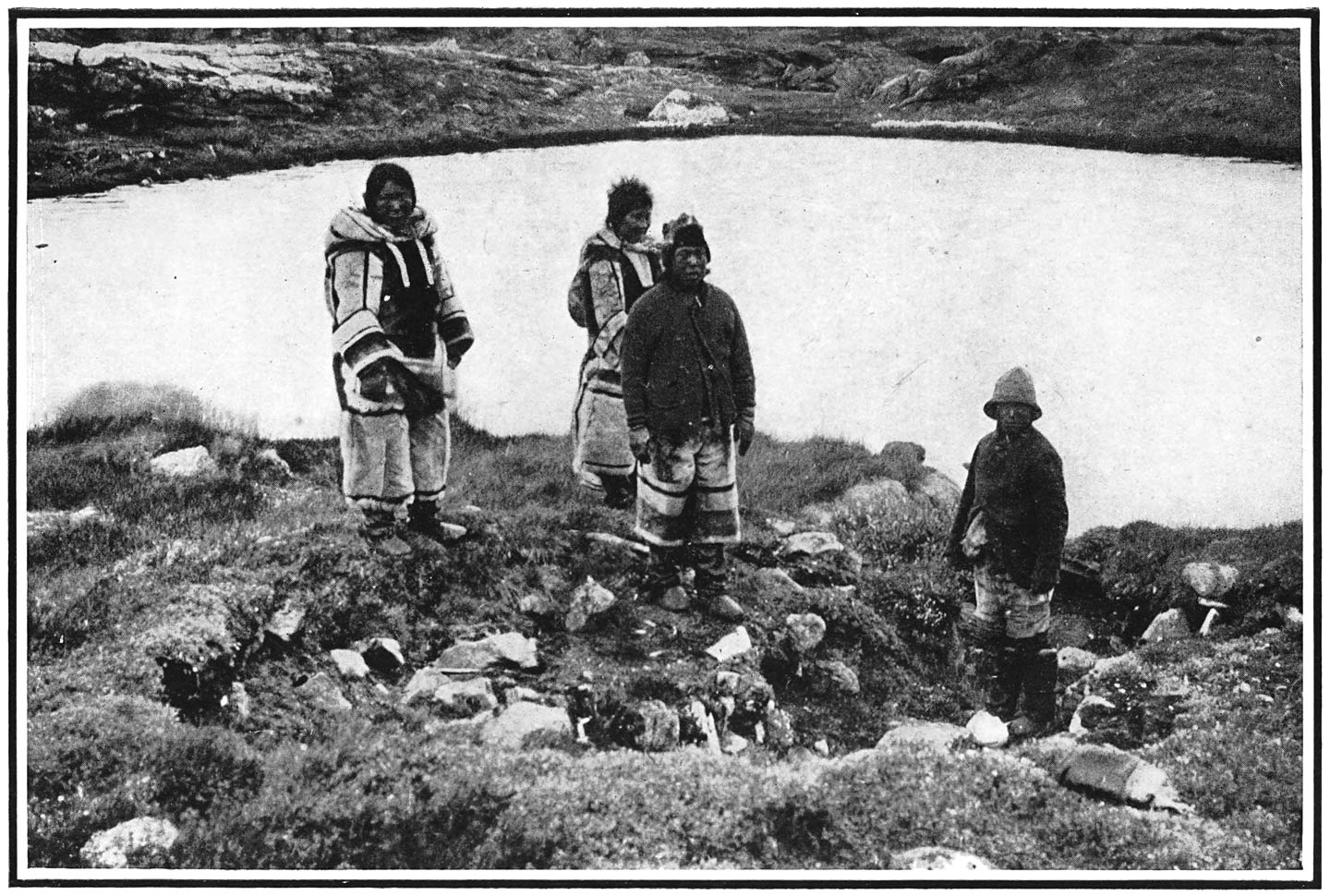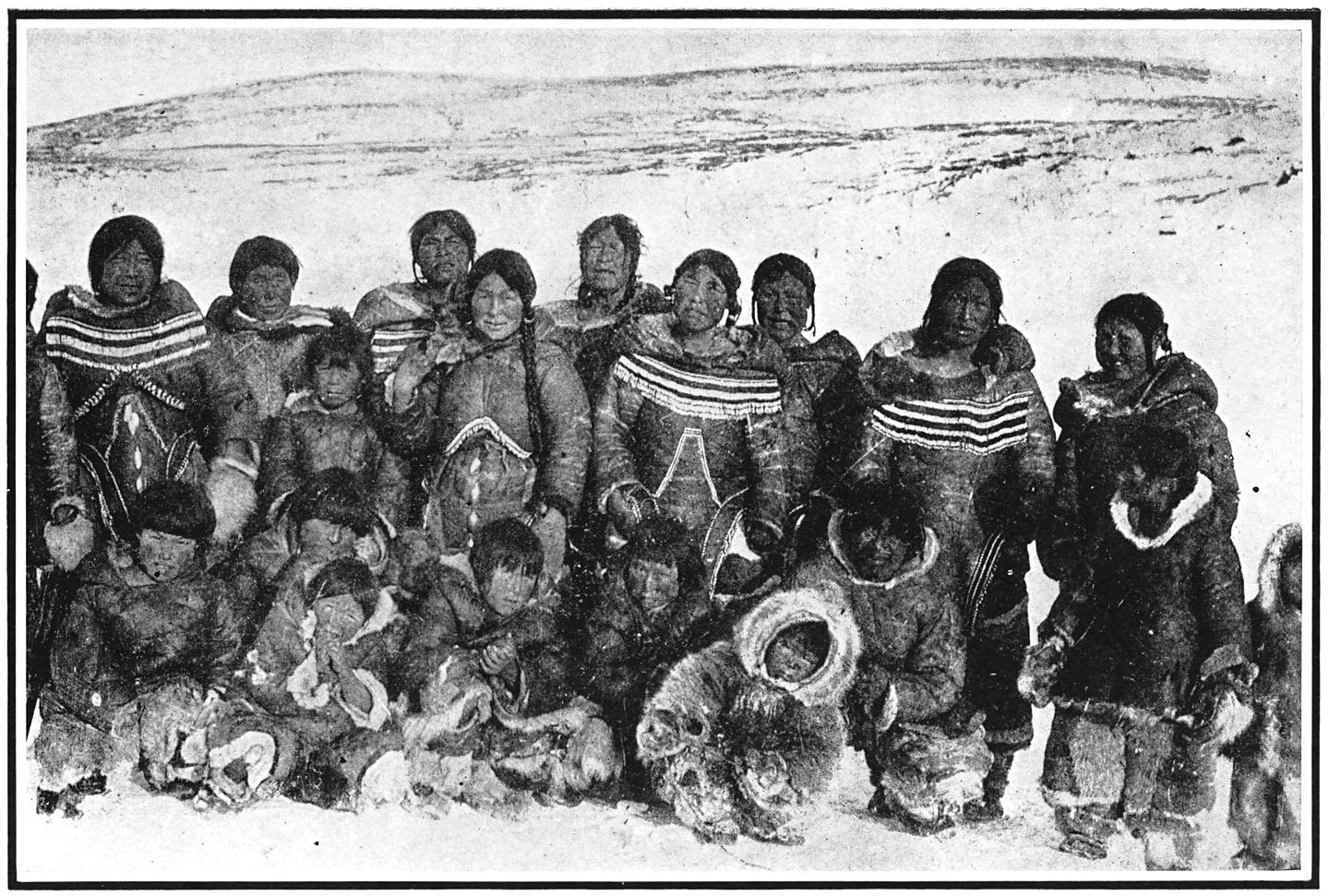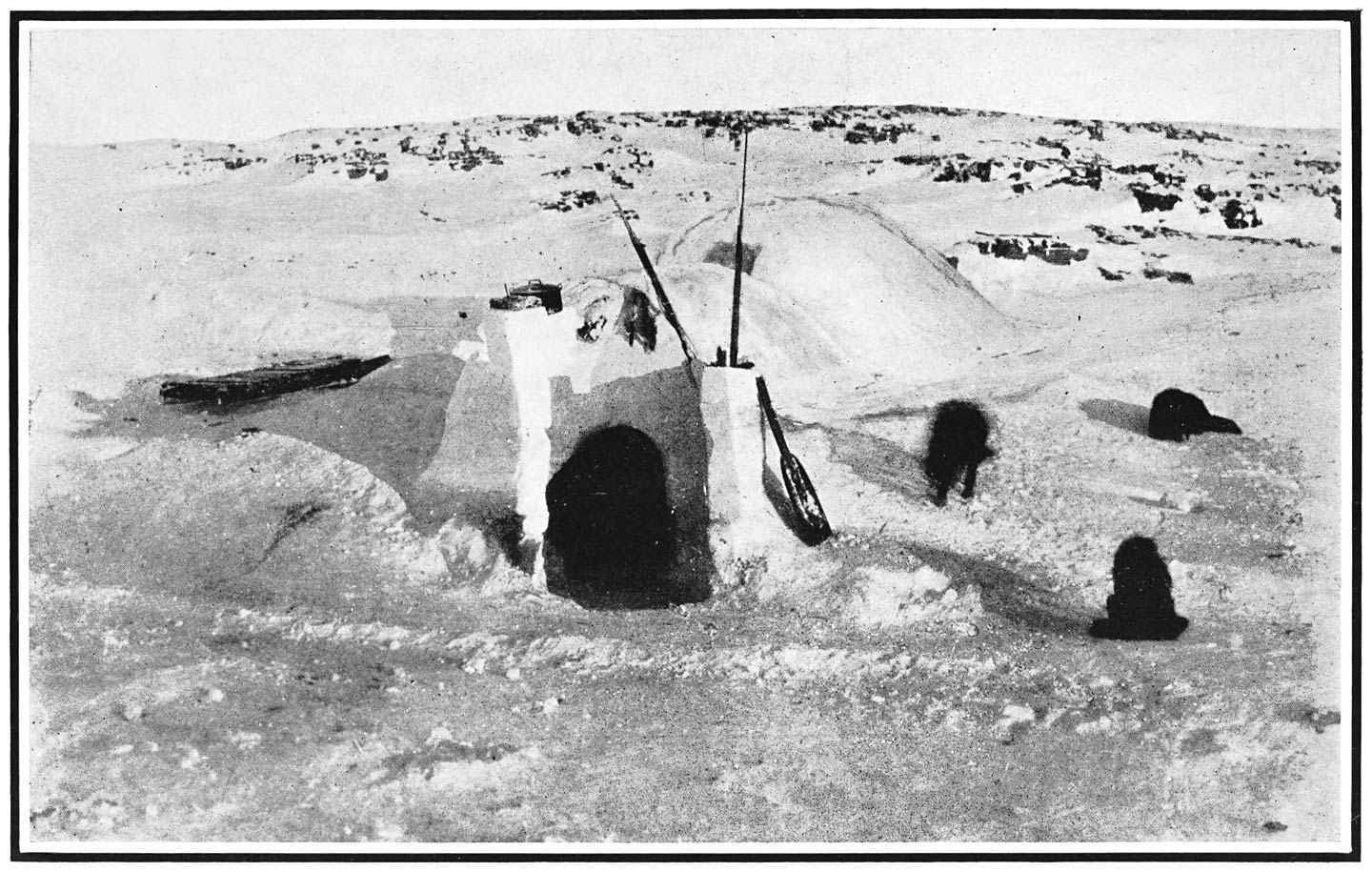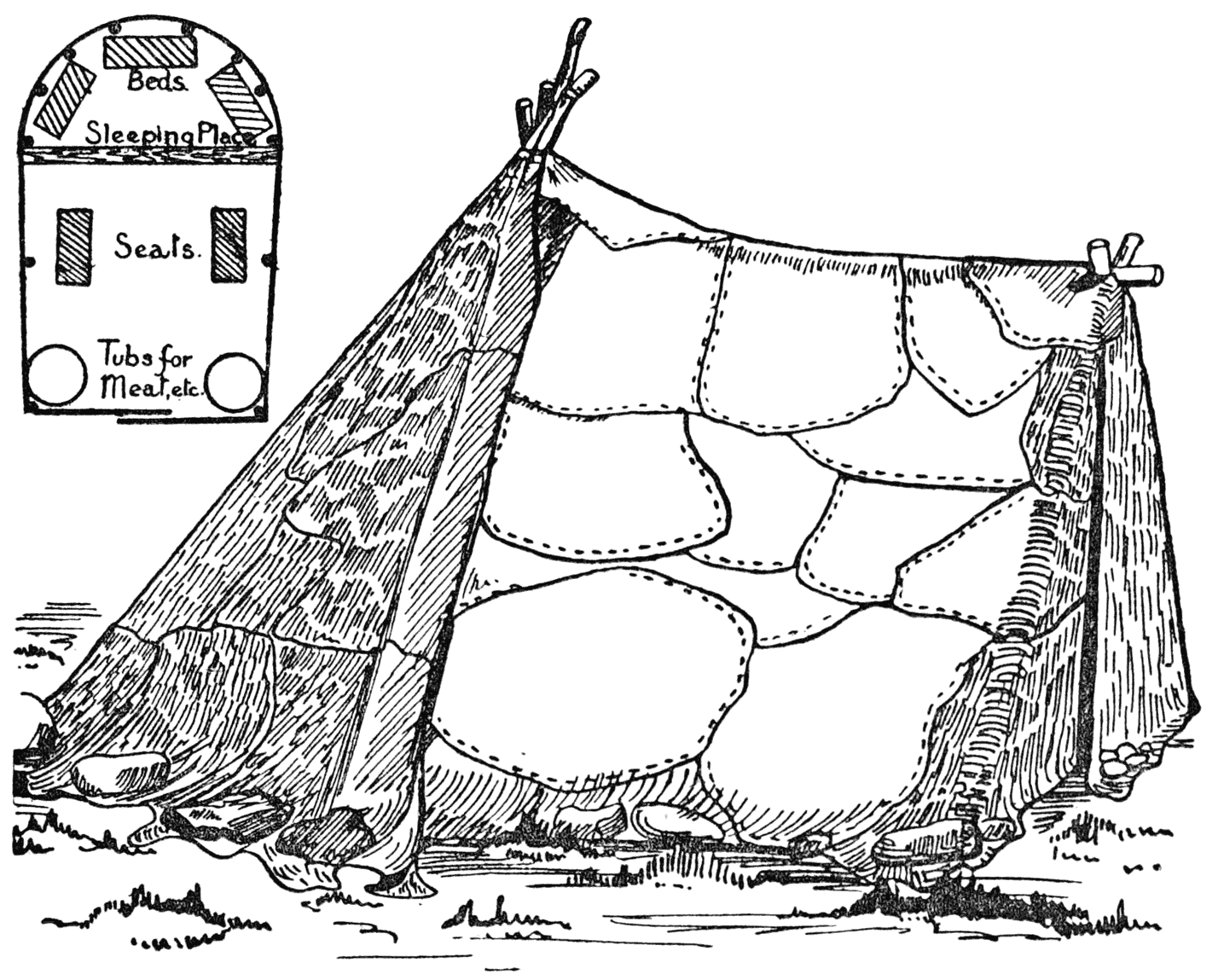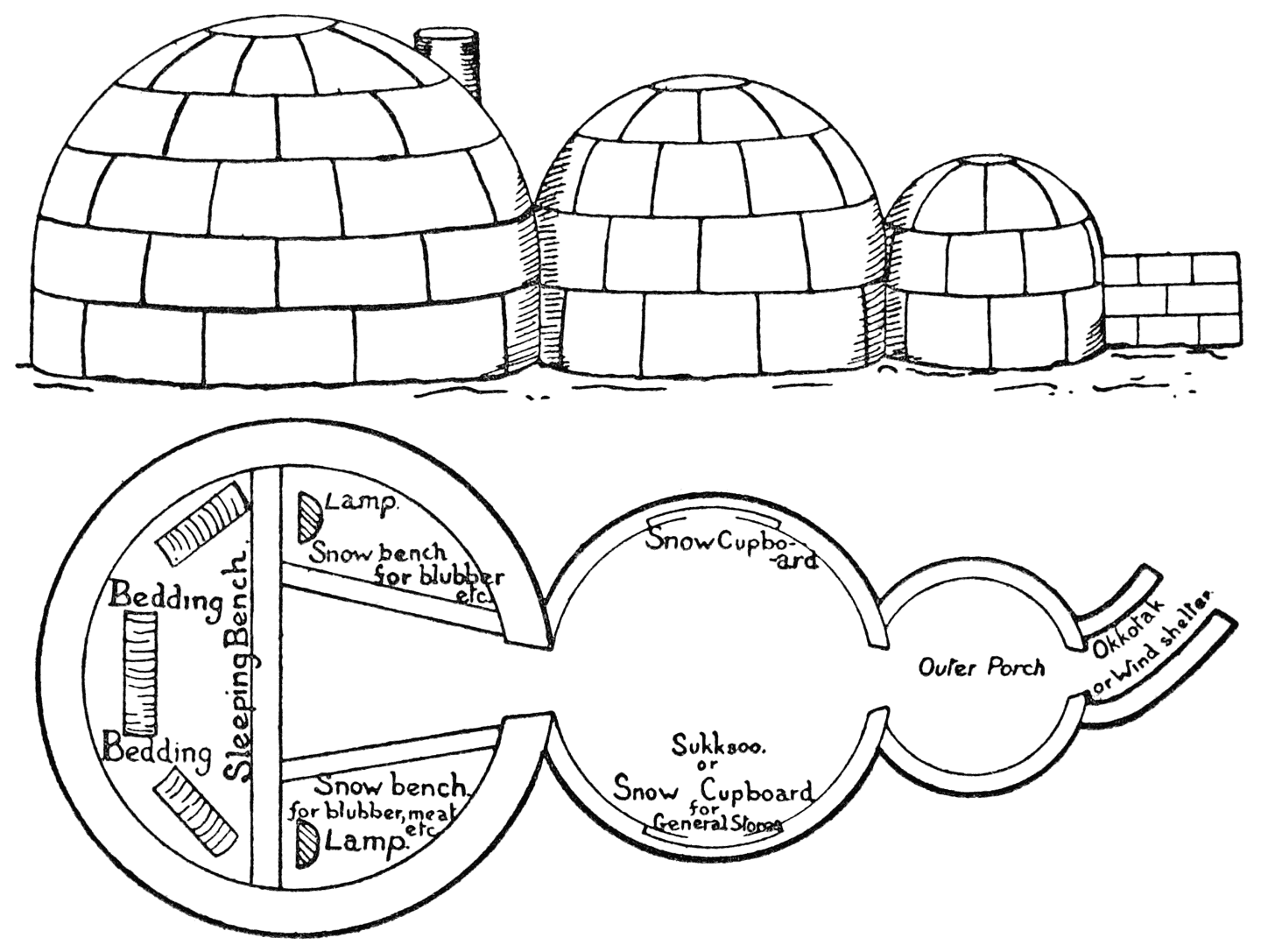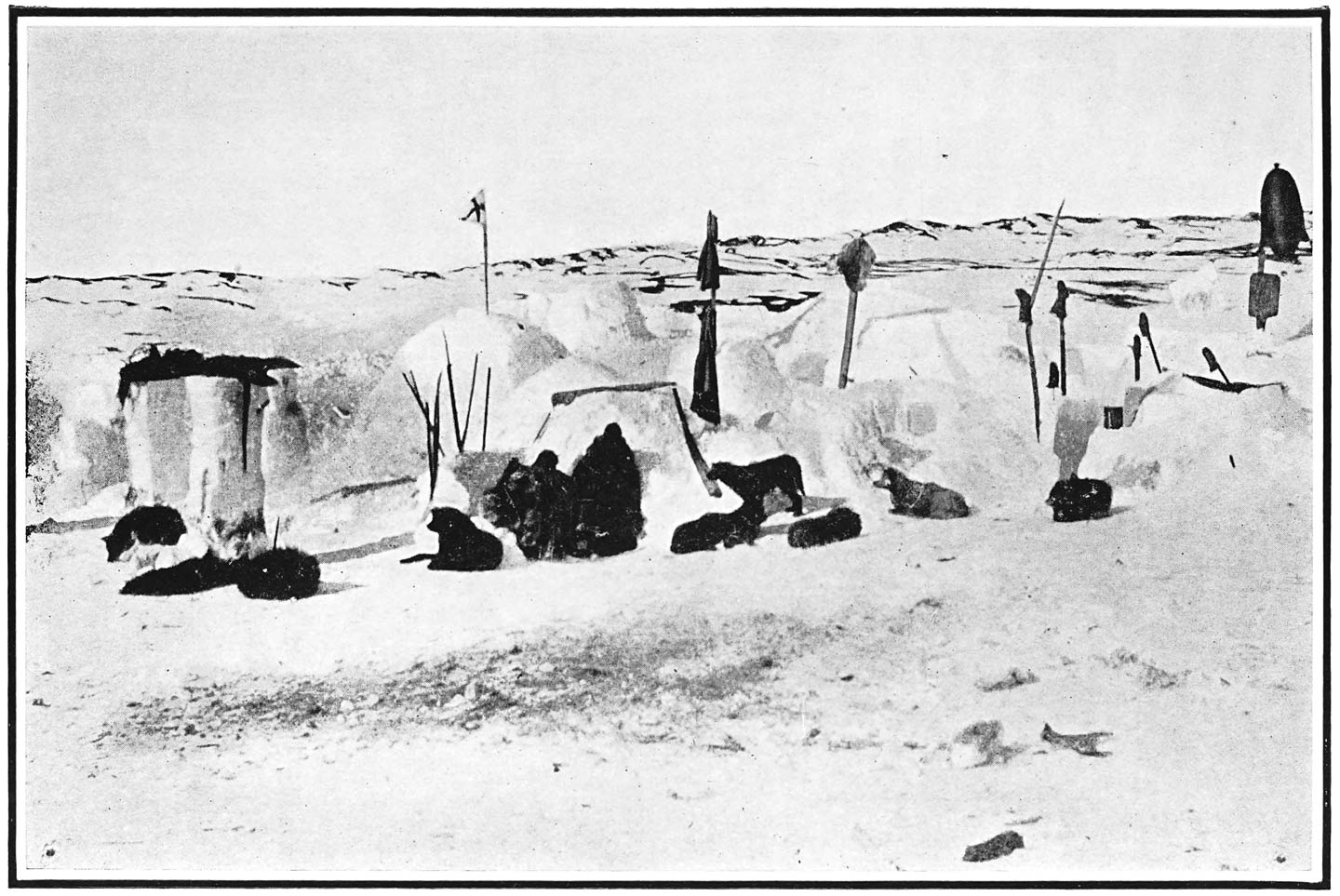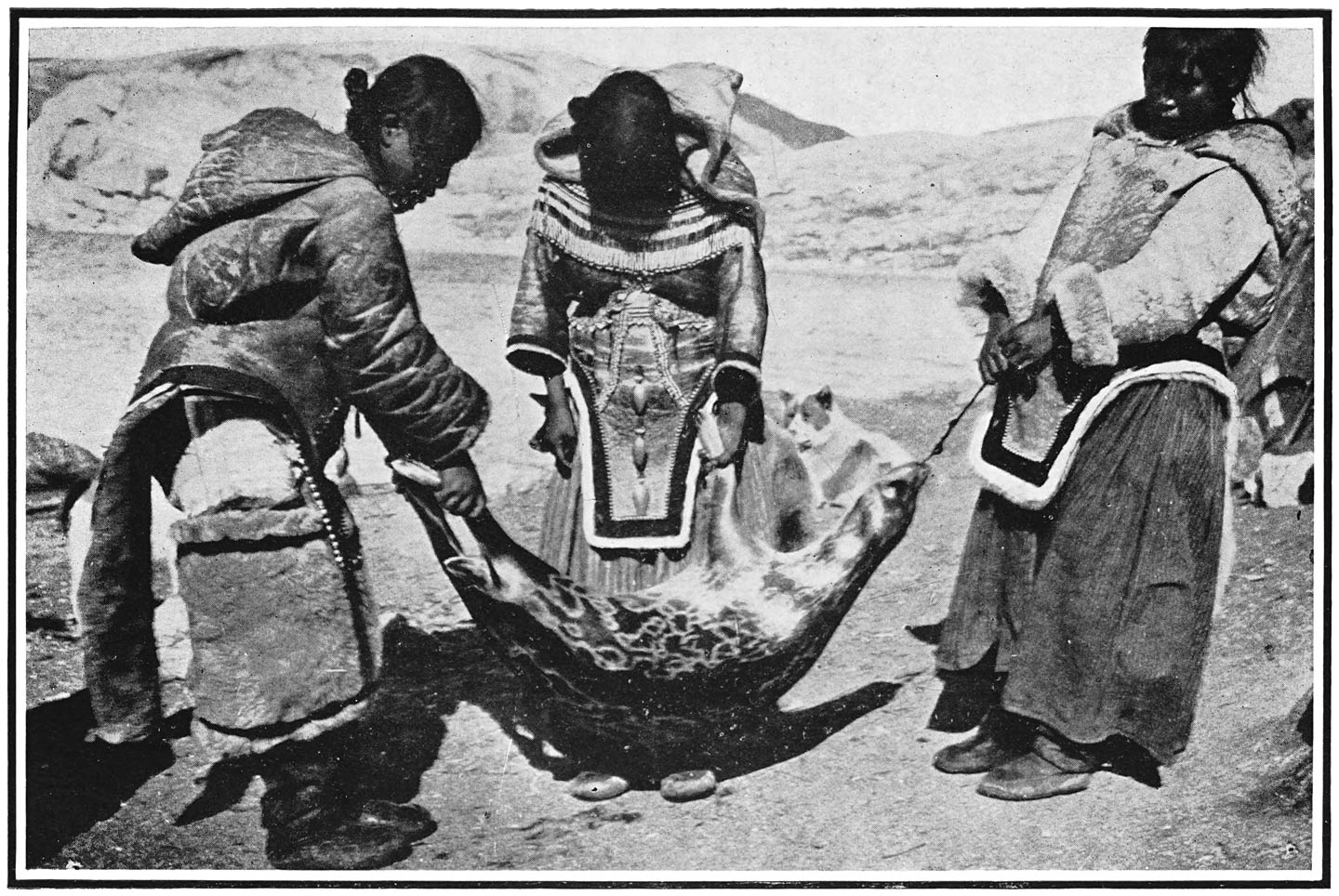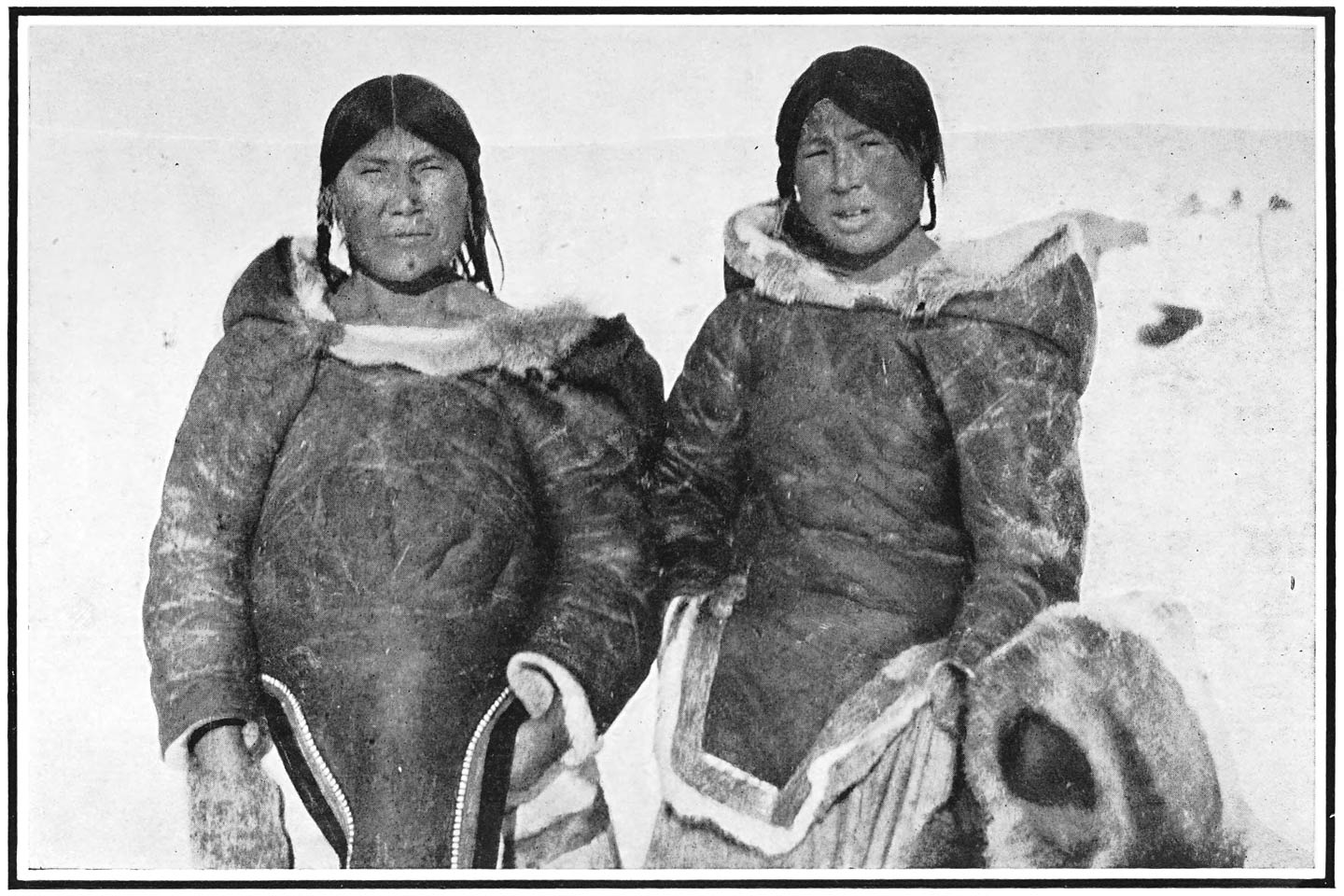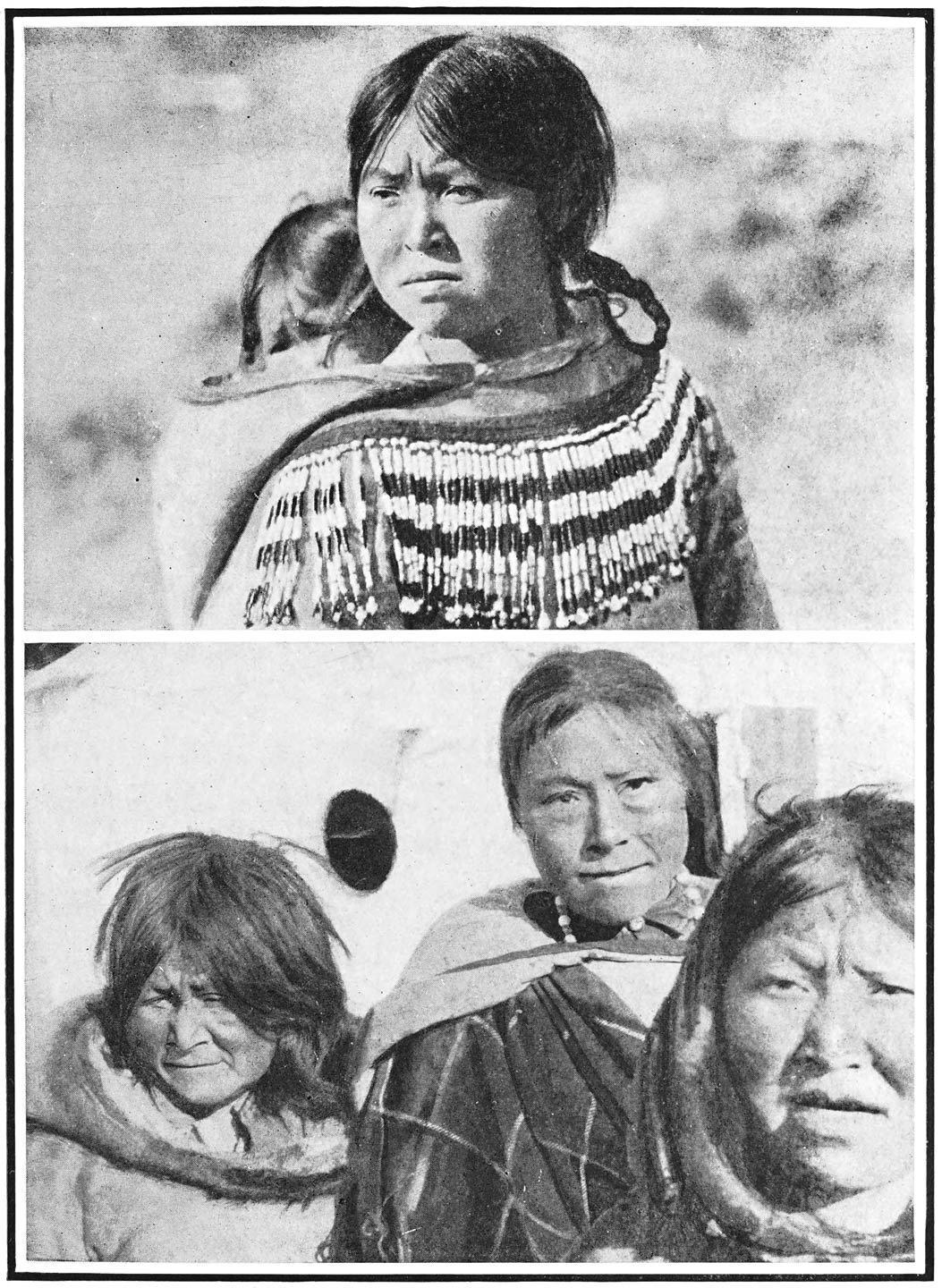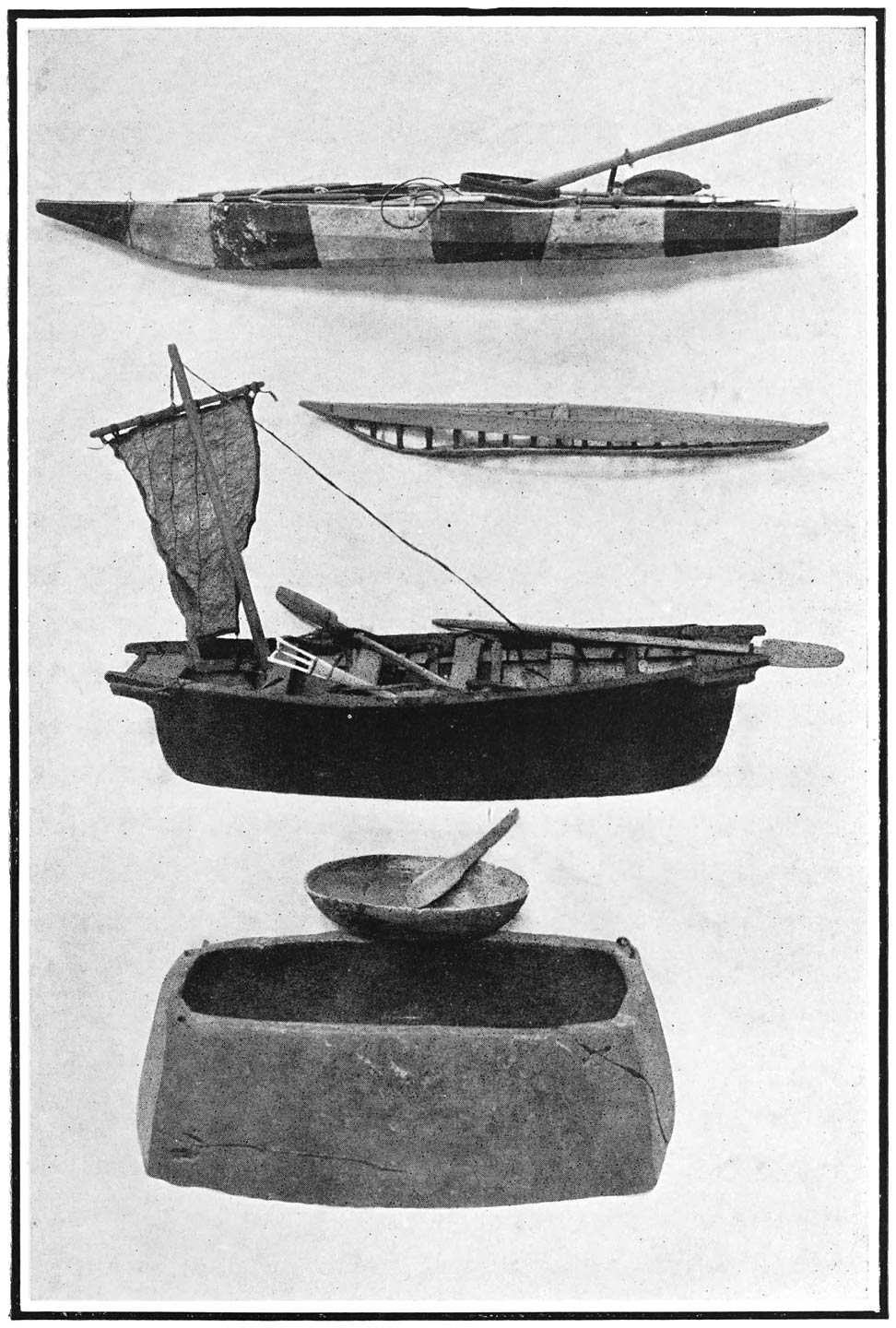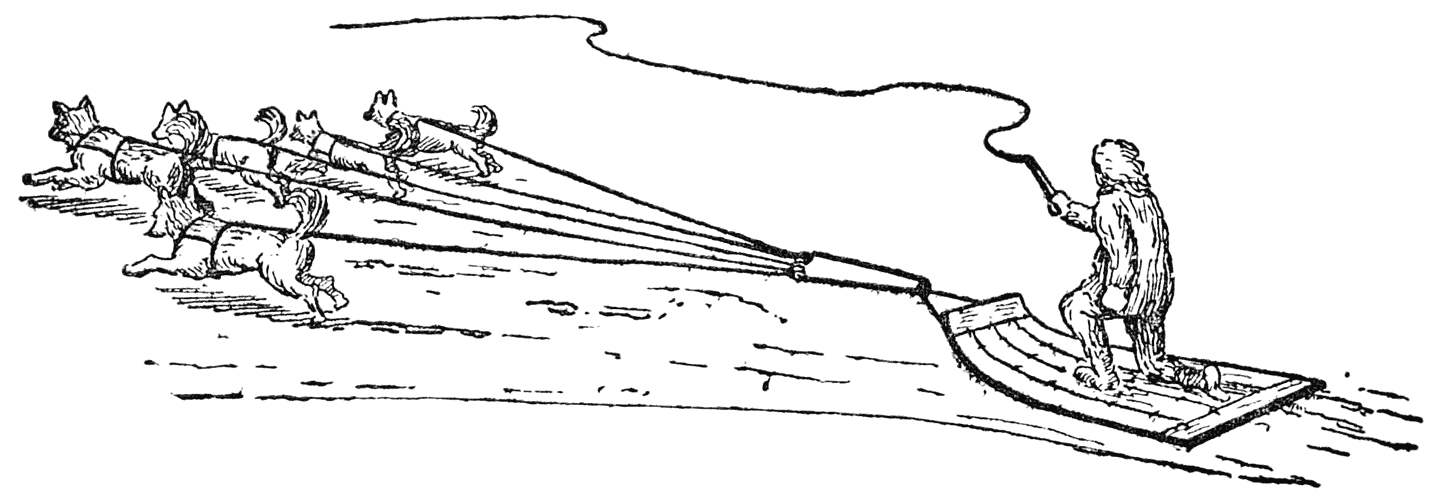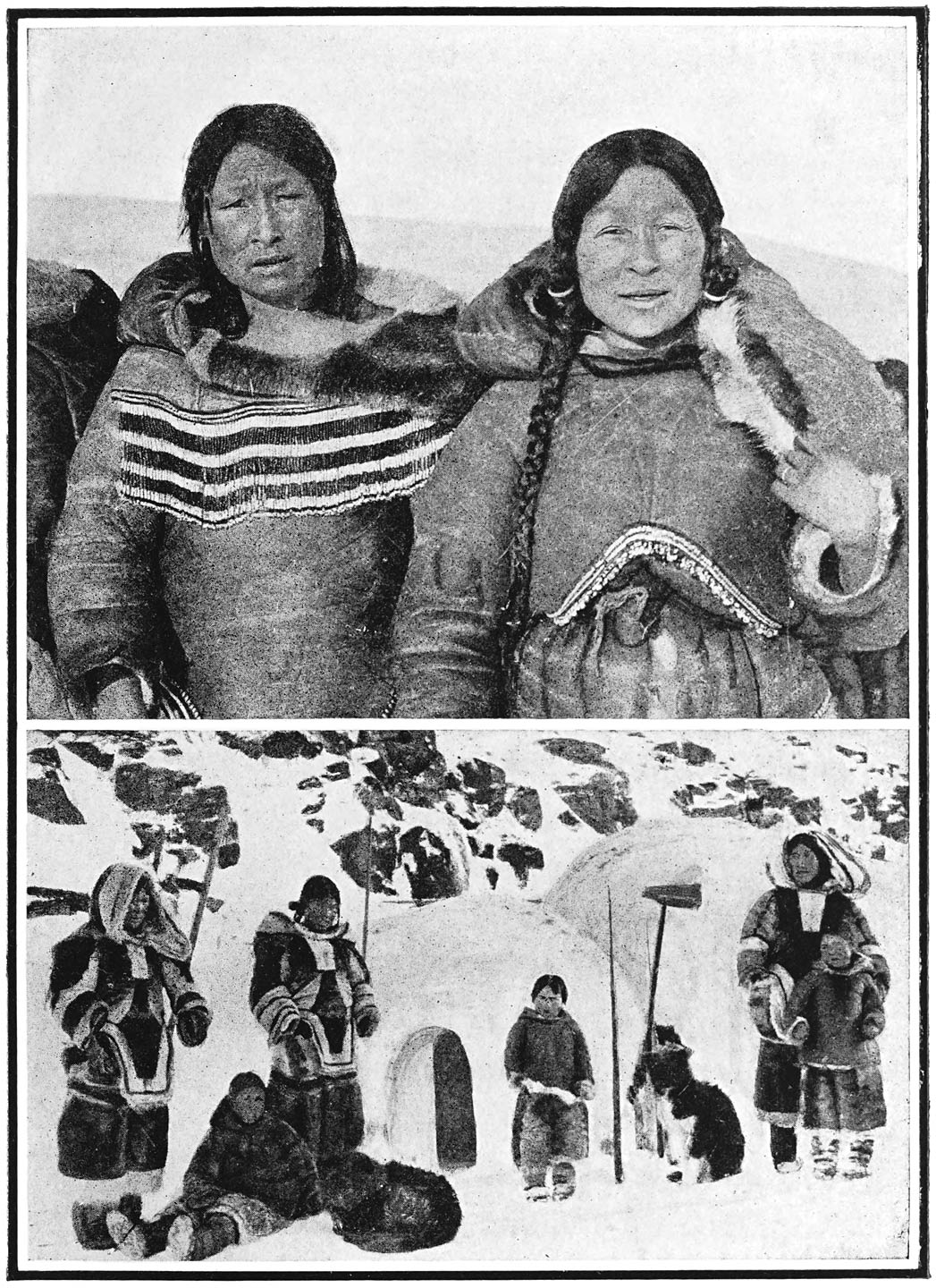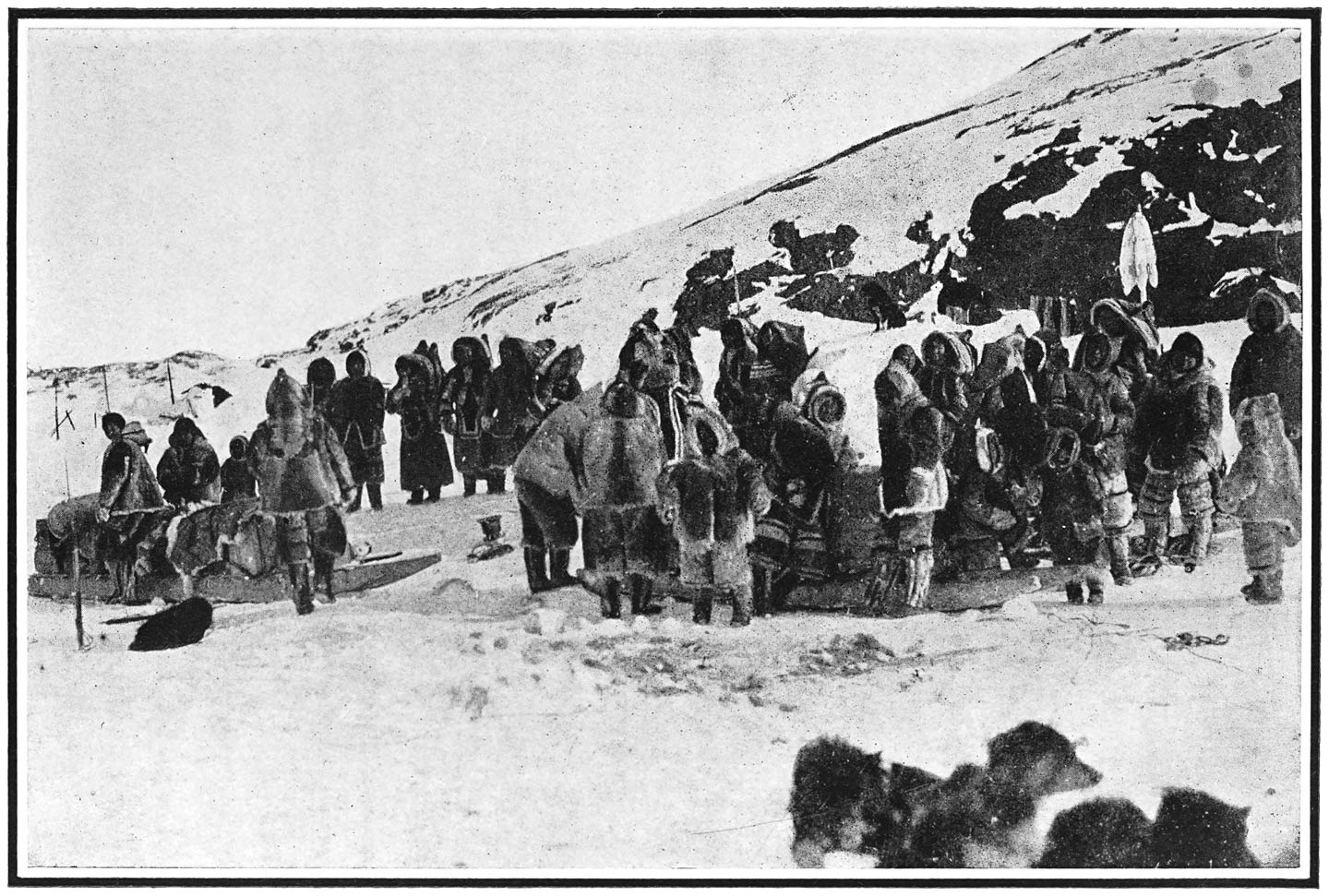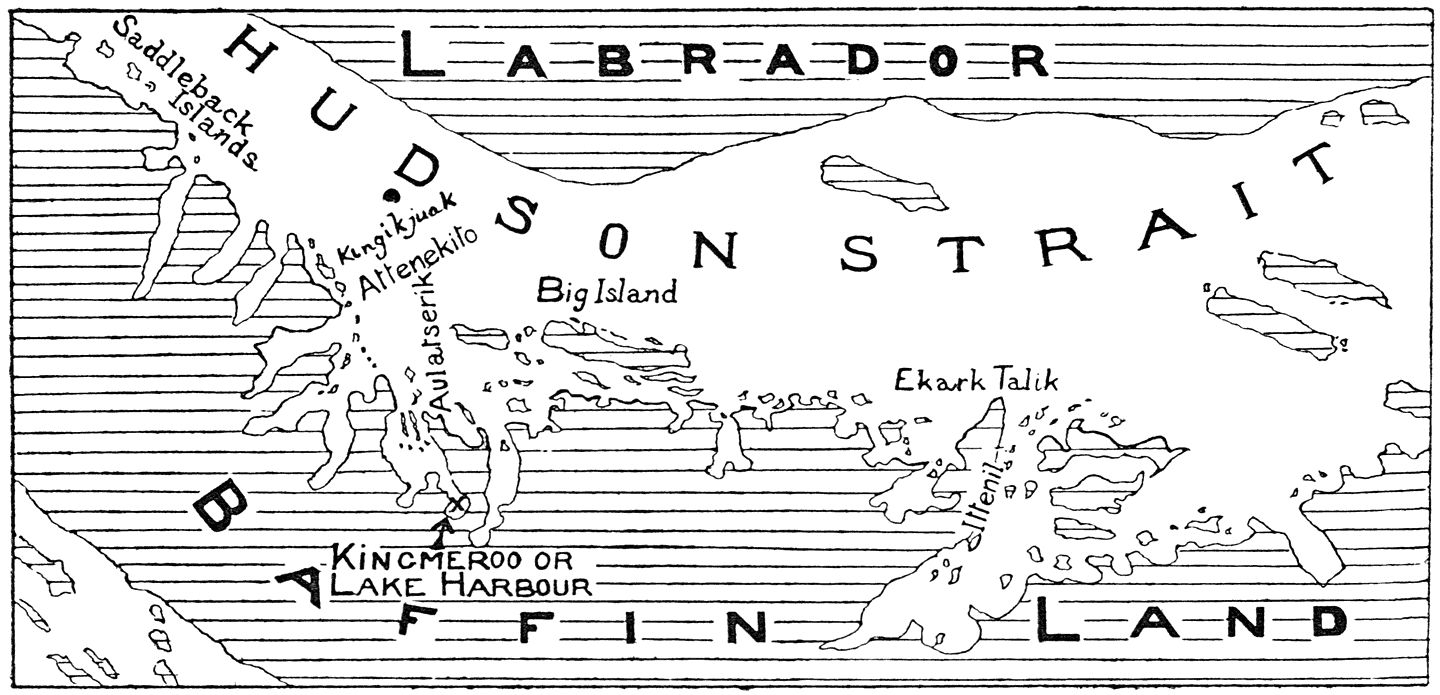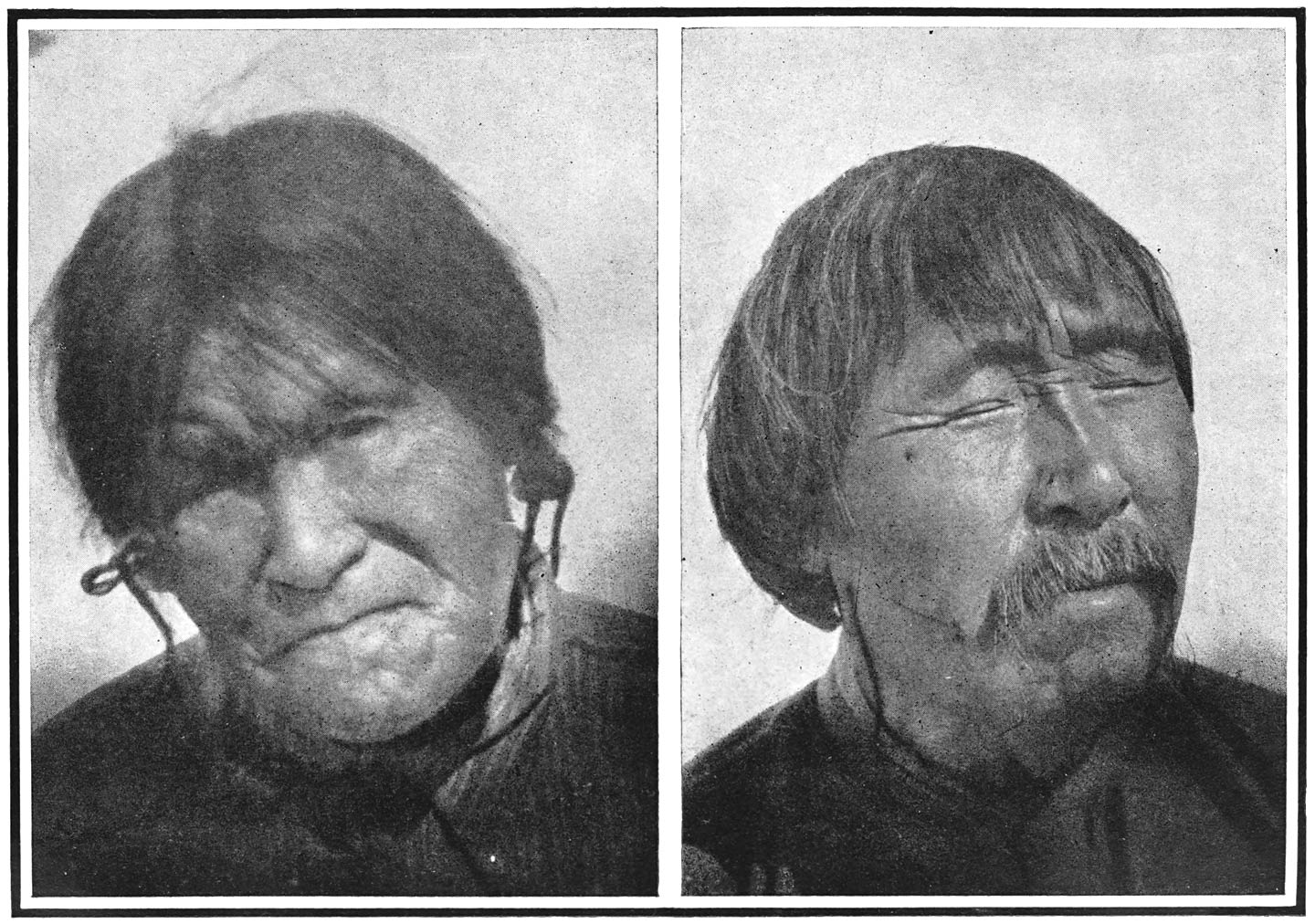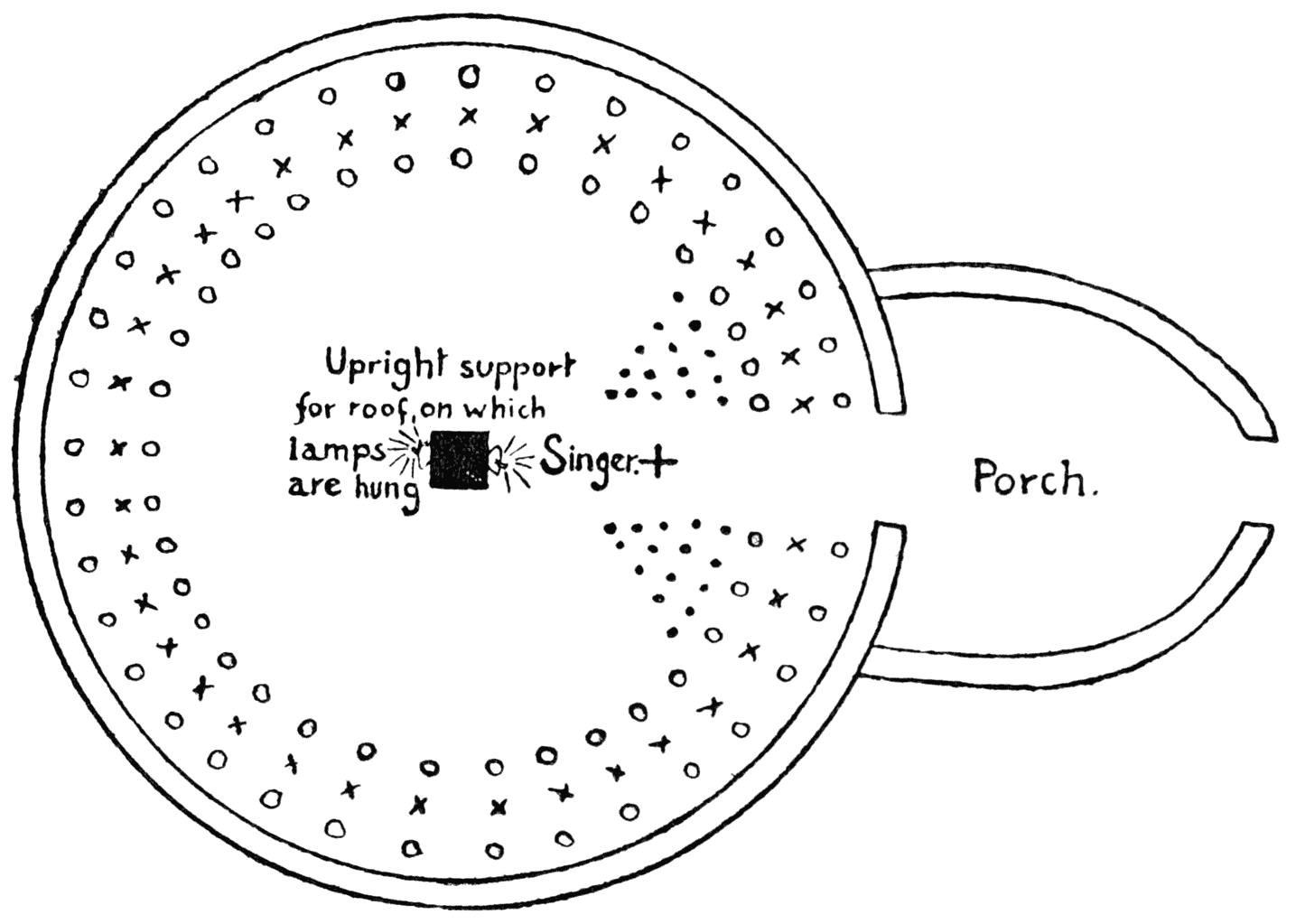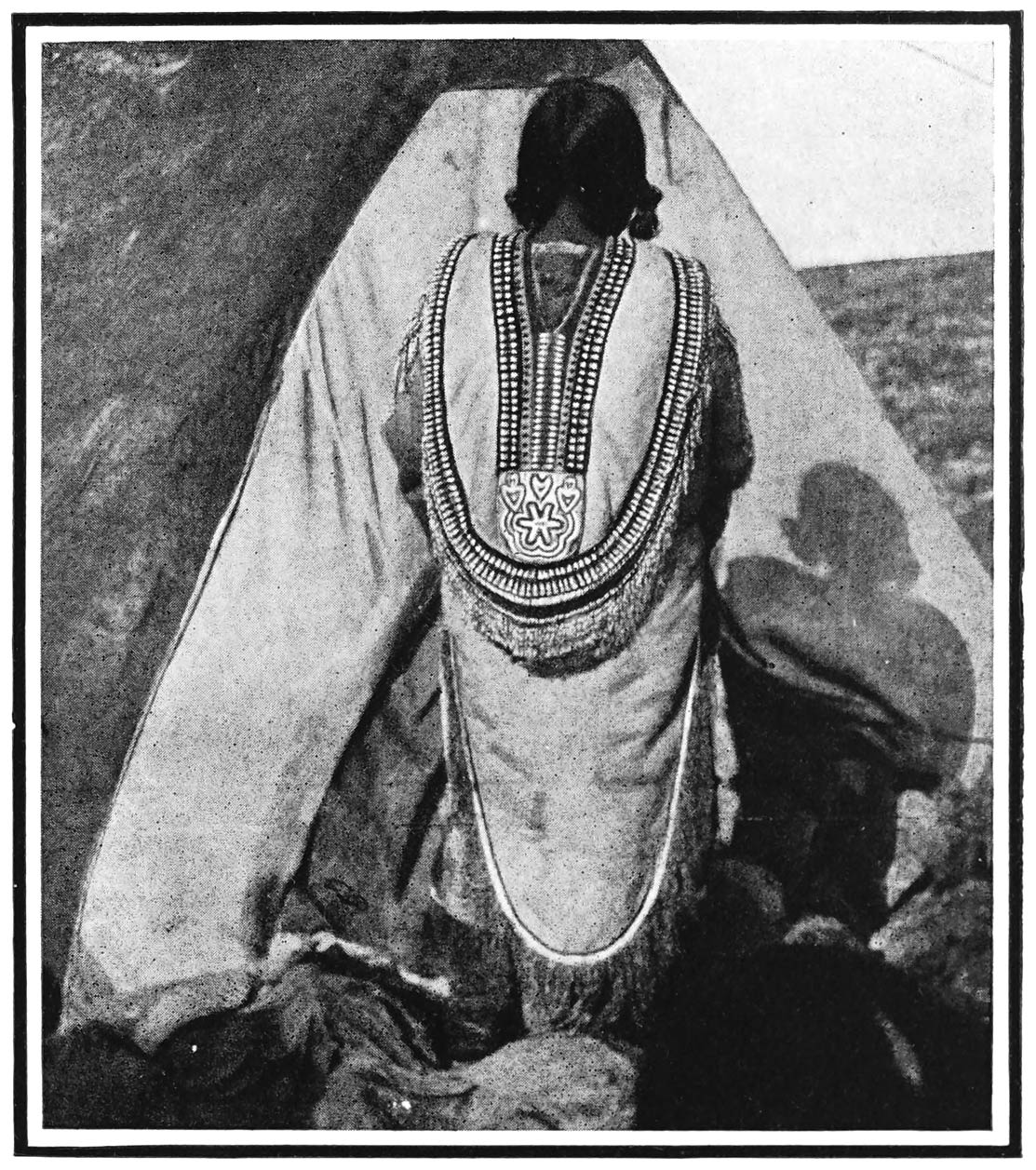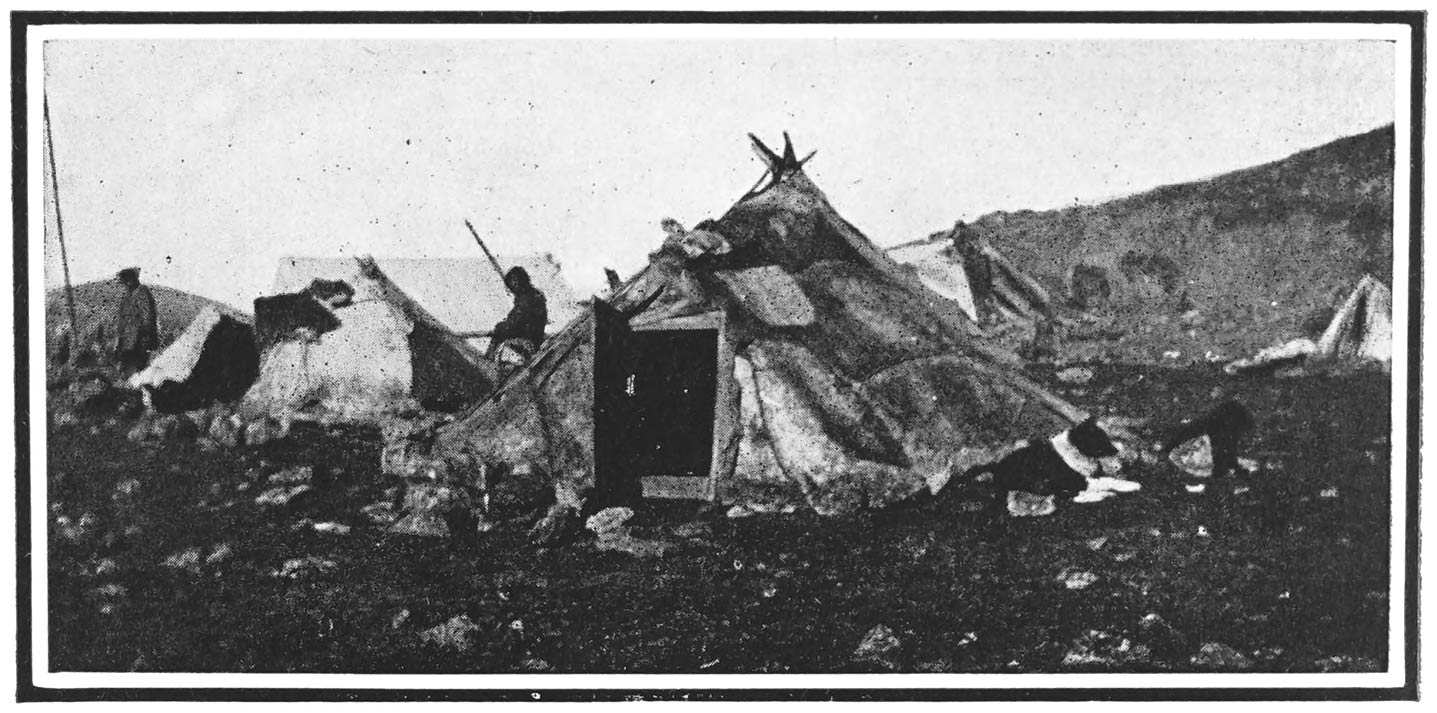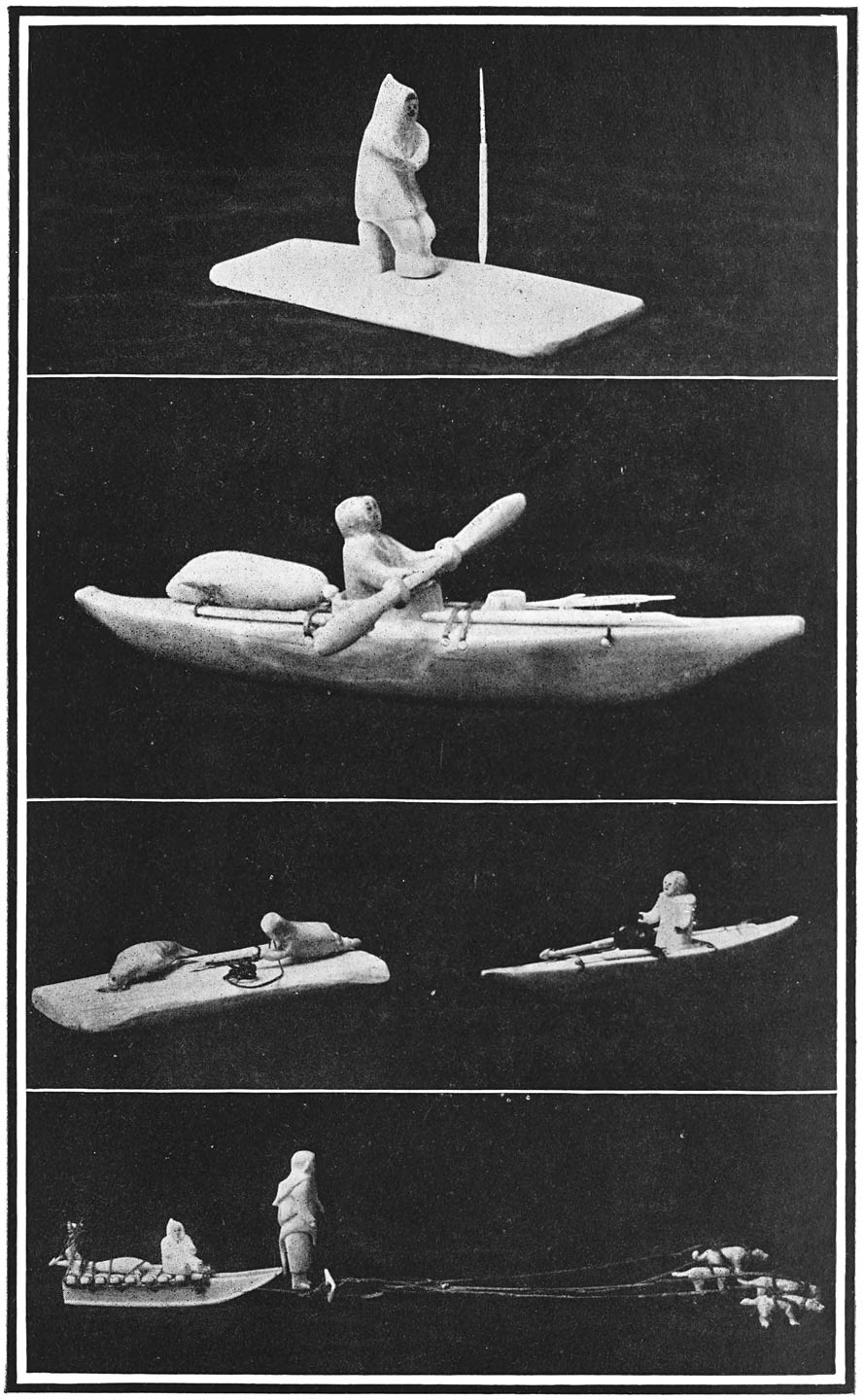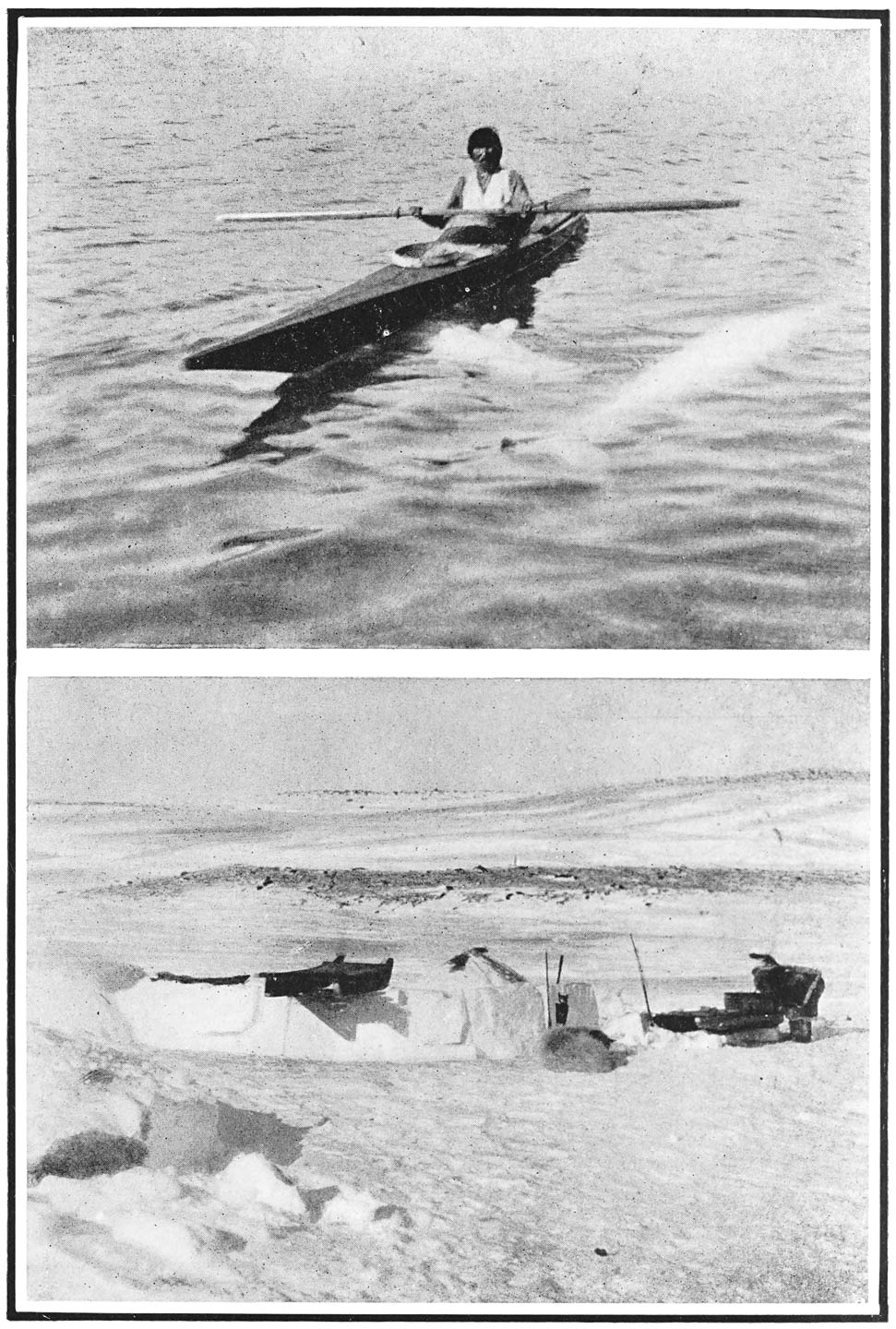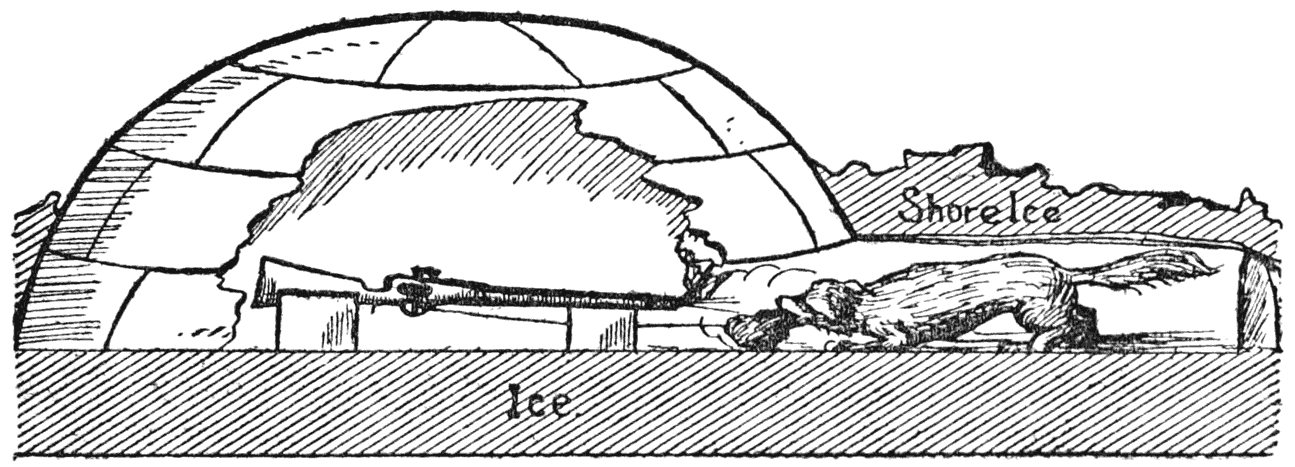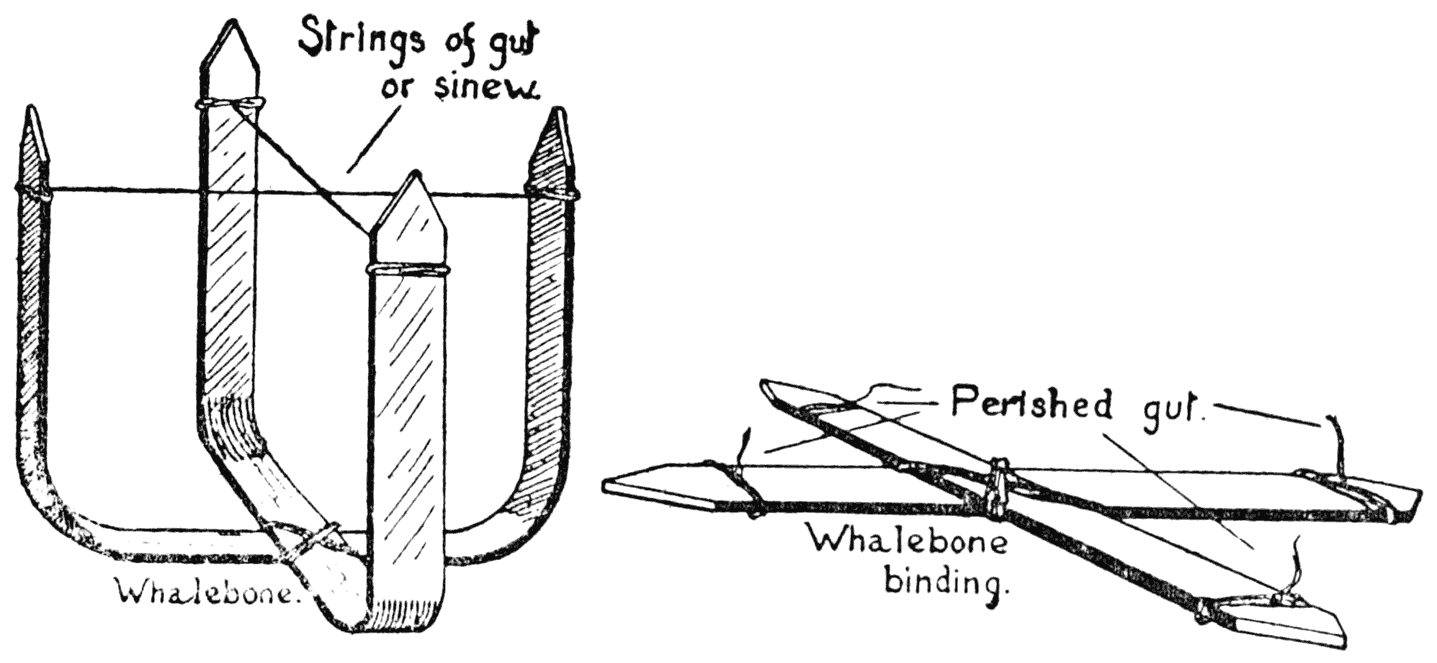In their family and tribal life the Eskimo carry out a very smooth running sort of
communism, the chief tenets of which are rigidly enforced peaceableness, open hospitality
to the stranger, and a sharing of food and the necessaries of precarious existence
among each other. Tribal government is wholly patriarchal in character. The Angakooeet, or chief conjurors—a class of men apart—hold the first place in public esteem and
common council. After them the village is ruled by the successful hunters, who foregather
with the former and with the aged and experienced, when it is a question of deciding
where to go and what to do about the hunting, or change of encampment, or treatment
of a delinquent.
The Eskimo have no idea of authority, except that which one man may exercise over
another in virtue of his superior wisdom, experience, skill or strength. There has
recently been some question of inaugurating a reindeer and musk ox industry on the
vast moss pastures of the hinterland of Baffin Land, and the purport of much evidence
given on this subject before a Royal Commission abundantly confirms the experience
[137]of the present writer, and emphasises the remarks that have been made as to the inadvisability
of rushing matters with regard to “civilising” the Eskimo, and radically changing
his mode of life from that to which the conditions of his environment have hitherto
formed him. Savage as these conditions are, the Eskimo has wrought out his own well-being,
and in his native state is as happy and contented an individual as could be desired.
He has his hard seasons of semi-starvation, when the hunting is poor; but even these
are borne with cheerfulness and equanimity.
“They seem to have the communal idea very strongly implanted,” said D. Jewess, Esq.,
one of the witnesses. “Theirs is a community in which one man is equal to any other
man. The idea of one man being a servant to another would not seem to be native to
the Eskimo; it is a foreign idea. It would seem that they must learn the whole idea
of one man serving another before they could be counted upon as reliable employees.
“An Eskimo will serve you faithfully on certain conditions, and will expect his payment
afterwards. He will serve you for a limited time and perform almost any work, and
will then expect his payment. The moment that payment is made he is an absolutely
free man; but for the period of work, if he understands his contract clearly, he will
serve you faithfully. They seem to work partly through the binding force of a promise;
but a great factor in keeping [138]them at work seems to be that of having them understand that they will be well rewarded
at the end. As is the case with all human beings, they vary; but on the whole they
may be considered as faithful as white people found in civilised communities. Experience
seems to show that they will keep to an agreement unless they get angry. In this event,
they seem to forget their promise. If they, in a casual manner, more or less promise
to do a thing, they are as likely as not to fail. Like most primitive people, if they
trust you they will do what they can to justify your confidence in them.
“At the present time the Eskimo is not responsible. He would make an excellent servant,
and in time an excellent trapper, guide and hunter. This is speaking of the Coronation
Gulf Eskimo, who have known white men only during the past four or five years. It
would seem that the Eskimo of Hudson Bay and of the east generally have other characteristics
which have been moulded through this influence. It is not thought that this contact
with white men is necessarily an advantage, if one is trying to convert the Eskimo
into a reliable, responsible servant or working man. A great deal naturally depends
upon the kind of white men with whom the natives have had to associate.”
It must be remembered that life in an Eskimo tribe is almost a family one. Each family
is interdependent upon the others, and all have close ties and relationships. Thus
anything which interferes with the [139]general harmony is dangerous and, in the unwritten law, a crime.
Matte, a good hunter and a man of standing in the tribe of X——, in the locality of
Z——, had for long disturbed the peace of the rest. He had quarrelled, had spread ill
reports about the doings of the hunters, had divulged their secrets, and been generally
independent and unsociable. For a long time Matte was a thorn in the side of his tribe.
He disregarded their customs and traditions, and became, according to Eskimo law,
altogether a first-class misdemeanant. At last he became unbearable. His big voice
and burly frame were no longer tolerable in the settlement. A day came when, in his
absence, the Angakooeet and chief men met in council to decide what should be done.
His case was reviewed and discussed at length, and arguments were brought forward
both for and against the accused. At length the verdict was given by the Angakut,
the Chief of the Conjurors, and ratified by the Council. Matte was to be put to death.
Five men were chosen by the Angakut, and instructed in their duties. Two were to hold
the prisoner’s arms, two his legs, and the fifth was to strike and kill.
As the time for the man’s return approached the executioners went out and waited for
him in the path outside the village. No sooner had he appeared than they seized upon
him. Matte read his doom in their eyes. He had but time for one ejaculation of despair
[140]when the knife struck through his breast and justice was done. The body was thrown
aside and left for the dogs and wolves to rend and devour.
The five men returned to their homes. One of them (the one who afterwards related
the story to the writer), married Matte’s widow at her express wish, and “lived happy
ever after.” The woman indeed was quite agreeable to the removal of her first husband,
as it was miserable to be the wife of so unpopular a member of the community.
Continued quarrelling, like that of this man Matte, is punishable by death. So also
is murder. A thief is banished from the village, but petty pilferers are merely sent
to Coventry.
Old people are held in great respect among the Eskimo, and their counsel is always
considered. They help as far as they are able in the household work, the old men repairing
weapons, harness, etc., and the old women in sewing or tending the lamps. In times
of scarcity, as in winter, meat and oil are always shared round. Directly a deer or
seal is brought in it is cut up and pieces sent to each needy family. In times of
plenty each family is supposed to provide for itself; but old people, widows and orphans
have always the first claim upon those who have the means.
Among these people, mutual kindliness is a general obligation. A widow or orphan child
is never left alone, but taken into the house and family circle of the nearest relative.
The widow gives her services [141]in return for food and lodging and clothing, and the child is cared for exactly as
the man’s own offspring.
Children have always the right of entry to any house and to partake there of whatever
food may be going. Women are seldom refused a like privilege. In times of famine children
are fed first, the women next and the men last. The writer has known a hunter to go
out four days in succession and meet with no success. He had shared a portion of seal
with another man who had caught one and cut it up as usual, but this had been given
to his wife and family, whilst he himself, taking no more than a drink of warm water,
went off with unimpaired cheerfulness to try his luck again.
Strangers and travellers, too, are always entertained and provided for so far as the
means of the moment may permit. A native arriving from another tribe and having no
relations in the village just puts up at any igloo he may chose—as a rule he will select the family best able to entertain him—and there
his dogs are fed, his equipment is repaired or the necessary material offered, and
food and a sleeping place provided for himself. Should he be on the trail alone, a
temporary wife is furnished him from the widows or spinsters of the community, and
it becomes her business to see that his clothes are dried and mended, and that when
he departs again he has sufficient food to carry him over the next stage of his journey.
The Eskimo are aware that in some respects European customs differ from their own,
and when [142]entertaining a white man his peculiarities are rigidly respected. The Eskimo standard
of morals is not that of the European. It may be that in this matter of the temporary
wife, as in the annual exchange of wives during the Sedna festivities, nature is making
her own instinctive provision for the continuation of a race; otherwise so heavily
handicapped are they by arctic conditions of life generally that without it wedlock
would scarcely suffice for the purpose. The Eskimo despite customs which look like
promiscuity according to the standards of civilisation, are not afflicted with the
diseases associated with European vice—until they come in contact with unscrupulous
whites. Either the germs of these scourges have not made their appearance in the Eskimo
communities, or the people are particularly resistive to them. That this latter supposition
is not borne out is evidenced by the havoc that has been wrought among the tribes
in the past. The Eskimo, when left to themselves, are a moral people according to
their own ideas, and the rude health they keep despite these strange customs, seems
to vindicate them from an unthinking criticism.
If he can, the wayfarer makes suitable offerings in return, but they are not necessarily
expected. He drops in on the family overnight, just perhaps when the hunter has returned
with a good fat seal, and the jolly distribution of it all round is going on. There
is a broad smile on the face of the housewife as she picks out the best bits for her
friends and leaves the scraggy remnants for those of whom she cannot profess [143]to be so fond. The children rush hither and thither, willing servitors of those who
cannot come themselves.
The blood is carefully scooped into an ice bowl for future stew or for the glazing
of sled runners. At the hospitable shout, “Kileritse! Kileritse!”—“Come ye! Come ye!”—everyone, friend and stranger alike, crowds into the house and
squats on the bench or the floor, or in the porch, and is duly served out with his
share. Nothing is heard for awhile but the crunch of strong ivory teeth; the red blood
stains hands and faces; black eyes glisten with enjoyment. Then, after a time, the
hum and clatter of talk rises to the smoky roof. Everything is devoured, even the
entrails (squeezed through the fingers to flatten and empty them). Reindeer moss,
taken from the stomach of a deer may be served up as well by way of that greatest
possible luxury—a salad!
Finally, everyone goes to bed. The doorway is blocked up, blankets are unrolled, and
men and women and children, stripped to the skin, wrap themselves up in these and
lie down with their heads towards the lamps and their feet towards the back of the
snow house, and sleep the sleep of health and good humour and repletion until the
break of another arctic winter “day.”
The children of an Eskimo community have quite a good time. Whenever infanticide has
been practised among these people, it was never through cruelty or wanton waste of
infant life, but simply because of a [144]dearth of provisions. As a matter of fact, the Eskimo prides himself on having as
large a family as possible. He is entitled to have as many wives as he can support.
It is not uncommon for a well-found man to have three wives—possibly sisters—all living
amicably together. The children are named after some place or object, and many names
descend from father to son. Thus we have “Moneapik,” the little egg; “Oonapik,” the little hunting spear; “Pitsoolak,” the sea pigeon; “Shokak,” roof of the mouth; and other names too crude for translation.
The pastimes of the children are just like those of children all the world over. On
fine days they romp with the puppies, as described elsewhere, or they borrow a sealskin
from their mothers and, finding a snow incline, drag it to the top and toboggan down
on it in fine style and with resounding glee. They build snow houses; play with little
improvised sledges; kick a seal bladder about by way of a ball; discover cat’s cradles
for themselves with any odd bits of thong; and get up to all the usual mischief with
bows and arrows. The girls make dolls. The boys have an ivory top corresponding to
cup and ball, and another game called “spearing the seal,” which is played by two,
with a piece of skin for the ice, and a bit of bone that moves about underneath it
for the seal. There is a blow hole, of course, and a miniature spear.
The education of the Eskimo boy all turns on hunting. All sorts of curious observances
wait on his first adventures in that line. When he secures his [145]first weasel, for instance, he gives it to the dogs, simply to be torn in pieces;
and that night has to sit up by the igloo door, one hand on hip and in the other a lamp stick. Possibly the root idea is to
defend himself from the spirit of the little beast. When he gets his first bird, Young
Hopeful sits in the middle of the sleeping bench, his mother on one side and his grandmother
on the other. The boy is told to take off his jacket, and the two women wrench the
bird apart between them in a sort of tug of war, to the accompaniment of cries of
congratulation. The mangled spoil is then eaten to bring good luck to the boy.
The following tale of the voluntary suicide of the old people who feel that they have
outgrown their usefulness to the community, and have rather become a burden to it,
shows how strongly the communal feeling dominates the Eskimo, how essential to existence
each one of them finds the social life of the tribe and village to be.
For many weeks summer has reigned in the arctics. Snow has disappeared. The ice has
broken up and drifted away to the south; only a few bergs remain, like the remnants
of a majestic fleet, wending their wandering way after the rest. For weeks on end
it has been one long, glorious day, when the sun has scarcely set an hour. The weather
is hot and the sky is blue. Arctic flowers and arctic heather gem the short turf;
streams and cascades fill the valleys with the unwonted music of running water. The
dogs lie about, basking in the sunshine, or betake themselves [146]to the seashore to hunt for fish and such toothsome morsels as may be left in the
rock pools by the falling tide. The village of sealskin tents is pitched in a sheltered
spot near some handy stream, overlooking the inlet. Contentment, ease and plenty are
the order of the day. The kyakers skim the waters of the bay, hunting as usual, and
in the evening the boys have a turn in the same light craft, to practice with harpoon
or birdspear. They vie with each other in skill and speed, and take lessons from their
elders.
The old men and women potter about, visiting each other. The crones occupy themselves
teaching the younger women how things were best done in their day, and the granfers
fight their own battles over again and exploit their own adventures, as they listen
to the talk of the younger men—the tales of more recent feats accomplished, perils
survived, and clever captures achieved. As the bright day wanes to that short twilight
which is the arctic summer night, the men fetch their blankets from the tents, roll
themselves up in them under the shelter of some boulder, and sleep in the open air.
The month of the eider ducks has come and gone. The women have manned their boats
and made their annual raid on the island where the birds breed, returning with hundreds
of eggs, plenty of ducks, and a goodly store of eiderdown from the nests. The days
have been one long, joyous picnic, all the hardships, privations and dangers of the
winter forgotten. The babies, brown and mother-naked, have sprawled about [147]in the sun and waxed fat and jolly, with the freedom and the play and the plenty of
summer.
But now the time has come to get ready for a very big annual enterprise indeed—the
great deer hunt, upon which the fortunes of the tribe will turn for months. If the
Eskimo lay up little store of food, they accumulate all the hides they can for winter
clothing. For several weeks before the start is made, stores of meat are prepared,
slices of seal cut and spread on the rocks, or hung on lines in the sun to dry. Piles
of moss and cotton plant are collected and dried for the winter’s supply of lamp wick.
Sealskins are cleaned and stretched and dried for clothing, boot soles, boat coverings,
and water buckets; intestines are inflated and dried for sail cloth and material for
making windows. The dogs are outfitted with sealskin panniers for transport purposes.
The trek ahead of the tribe is a long and laborious one. They will journey for many
days by water up the rivers, and climb long ranges of hills and cross many valleys,
before they reach the interior and the pastures of the deer. Each man, woman and child
must shoulder his own pack, for none can carry a double load. And so, it often chances,
comes the tragedy of old and enfeebled age.
Seorapik was an octogenarian. Her hair was grey and her back was bent. She had managed,
somehow, the previous year to carry her belongings on the long, long trail, and to
stumble along after the tribe. But at last the bitter fact forced itself upon her
that she [148]could follow the hunters no more. She must stay behind—alone. She could no longer
carry her load nor keep pace with the folk on the way, and none might carry her. She
had no alternative but to remain in the deserted village and await the tribe’s return.
Now Seorapik, like every other Eskimo, was an intensely sociable being. She loved
nothing so much as to hear laughter and jokes about her, and to be in the thick of
all the village talk and doings. As she faced the prospect of the long lonely weeks
ahead, in the lifeless silence of the empty camp, with the days growing ever shorter
and colder, without a soul—except perhaps a child—to bear her company, her heart quailed
and grew very heavy. There was the danger, too, of attack by wolf or bear, and of
sickness coming on—and death. Death, all alone! True, they would leave her a plentiful
store of food—the good village folk—and lots of skins; but what comfort could these
afford her in their absence?
But the law of the North is stern and immutable.
They knew it—those sons and daughters of hers, and all their sons and daughters. They
grieved for Seorapik, and remembered her many acts of kindness to each and every one
of them, and her life of cheery toil spent wholly in their service. They had a custom
to be sure—but it was hard to endure it when it came face to face. A familiar custom,
designed to meet such as case as this; but a heartbreaking one, all the same. Seorapik
remembered it, too, and was the first to summon the courage to announce it.
[149]
She proposed to bid the tribe goodbye rather than let it take leave of her. Her time
to go on the long, lone journey from which none ever returned could not be far off
in any case. She decided to anticipate it. She could not face seeing her folk load
up the packs, start out on the trail, without her, and disappear over the hills. She
could not contemplate the intense loneliness that it would all mean, and miss the
laughter of the children, and even the rough and tumble among the dogs. So the dread
subject was broached to her son.
He gave his assent. Itteapik announced the decision to the villagers, and they came
to help with the preparations for Seorapik’s death.
A rough, round igloo was built, and the old woman withdrew into it, taking her few belongings, escorted
by all her kindred and friends. They encouraged her to the last with every kindly
and sympathetic thing they could think of to say. She braved it out, and, with her
cheery but quavering goodbye still in their ears, her loved ones blocked up the entrance
to the little death chamber in such a way that no dog or wolf might break in.
And there she sat down slowly and willingly to starve to death, quite happy so long
as her children continued to come from time to time and call to her from outside,
and tell her all that was going on, every single little thing that happened.… She
never asked for food or drink; they never gave it.… She never wanted to come out;
they never moved a [150]stone.… She simply had to go. Their part was to make her last days, her last hours,
as happy as they could, simply by being there—quite close—outside.
Then the time came when the feeble voice just ceased to make one more response. She
had gone on her own long journey first, to the land where parting would be no more,
nor the fear and sadness of it. Her last hours had been happy ones, cheered by the
sounds of the village life, the cries and gurgles of the babies, the shouts and cat-calls
of the boys and girls, the murmur of men and women talking over their accustomed tasks.
She had no loneliness to bear, after all, no desolation, no silence. The old Eskimo
died with a smile of love and contentment on her face, with a long record behind her
of woman’s good and motherly work, of a humble, “primitive” life indeed, but lived
according to what light she had—and so into the better life beyond.
There was Nandla (the spear), too, the blind hunter, who also went to death under
the lash of arctic circumstance.
The incident took place near Davis’ Strait, and was related to the writer by one who
had witnessed it. Again, the inexorable law of the wild left one handicapped as Nandla
was no choice. The man was comparatively young, but by reason of his blindness useless
to himself and a burden upon others. In a hungry land, where every extra mouth to
be filled represents a problem, there is no room for one who cannot provide for himself.
The severity of the code [151]of the North is very great. It cannot be judged by the ordinary standards of humanity.
Spring was at hand—the joyous spring of the arctics. The days were lengthening and
the seals increasing in numbers. They were coming up from the south for the breeding
season. In the village all was life and bustle. The hunters were full of preparations,
and the dogs scarcely less so. The boys were loading the sleds and harnessing the
teams. One by one, each hunting outfit glided off over the frozen ground, out towards
the bay.
Outside his snow house sat Nandla, the blind hunter, listening to every sound and
seeing every detail in his mind’s eye. His heart was heavy as lead. In his younger
days he, too, had gone forth just like these others, to spear the season’s catch,
and come home rejoicing with a heavy sled. But repeated attacks of snow blindness
(despite his wooden snow goggles) had destroyed his sight; and here he was, in early
middle age, a useless, hopeless, helpless man, tied to the house, dependent upon his
folk for food and clothing, and a drag upon them all.
Each night, as the hunters came home, the whole tribe gathered as usual round the
cooking pots, when the excitements and doings of the day would be discussed with no
less gusto than the food. Nandla always had his place in the family circle, and eagerly
drank in every word the hunters had to say. He longed to hunt again, himself; to bring
back the kill, to see the children come pushing into his house for [152]their share, and to bid his wife give generously to the aged and the destitute! In
his mind he pictured it all: the village nestling in the bay, huge, snow-clad cliffs
rearing up at the back of it, and overhead the pure blue of the bright sky, where
the glaucus gulls wheeled and cried. He pictured the scavenger ravens perched about
everywhere, on the look-out for bits; the vast expanse of the frozen bay, glaring
white in the cold sunlight; and beyond, a heavy black mist smoking up in the wind,
marking the water line. Out there were the hunters—mere dots—moving about in the still
immensity.
And here was he—Nandla—idle and useless, unable to occupy himself even with such tasks
as fell to the ancients of the tribe—the repairing of lines, harness, and weapons.
He could not patch up a snow house any more, or trim a lamp! Often, during the months
of severe weather and of scarcity his relations had been hard pushed to find the wherewithal
to feed him or clothe him. Nandla was very wretched.
At length, one evening, after just such a bad spell of weather and of luck, Nandla
begged to be taken out on to the hunting grounds. Now, his relatives had been thinking
things over rather grimly, and had seen nothing ahead for him but long years of misery
and possibly of want. The problem suggested but one solution. It was simple enough.
This request of the blind man’s to be equipped once more for the hunt and taken along
with the rest, gave them their opportunity. They fell in with his desire and made
their [153]plan. They knew of a certain rout where danger lay. Nandla should be taken that way.
It was neither treachery nor murder they planned, but an end for the afflicted man
of his anxieties and griefs. Nandla set out that morning full of delight. His heart
was full of unwonted excitement. He yelled to the dogs and bumped and glided over
the ice on the sled with a long missed sense of exhilaration.
They soon reached the grounds. Nandla’s guide seized his hand and led him towards
a gaping seal hole.
“Follow me!” he said, dropping the other’s hand and lightly stepping to one side.
“I follow!” replied the sightless man, and straightway fell into the hole.
He went right under, then and there—under the ice—and was immediately drowned and
frozen. A handy piece of ice served to seal the death trap, and all was over. Nandla
had died on the hunt, and had entered the Eskimo heaven like the other valiant men
of his tribe, and taken his place with the doughtiest of them, where there would be
joy and plenty for evermore.
[154]



